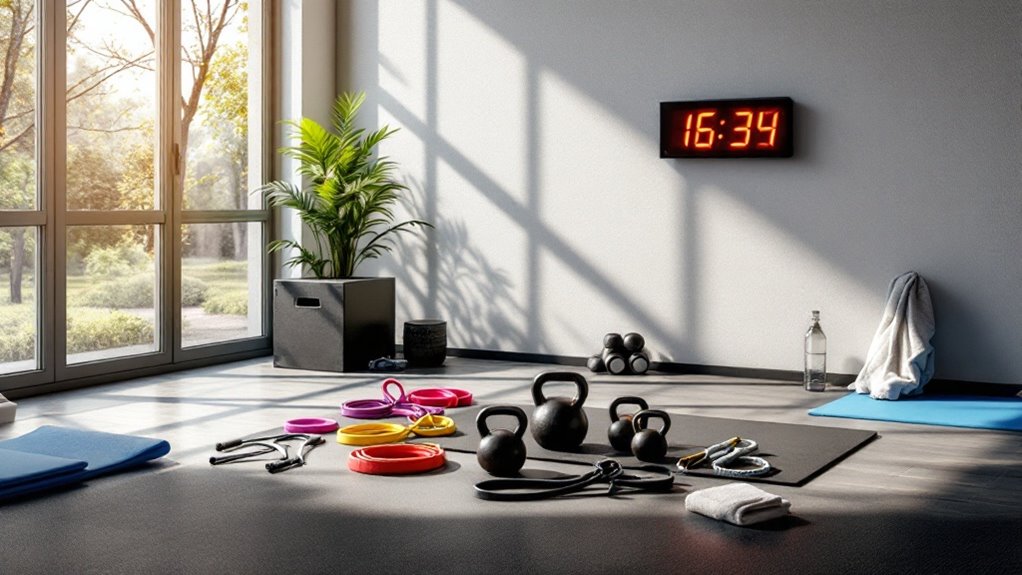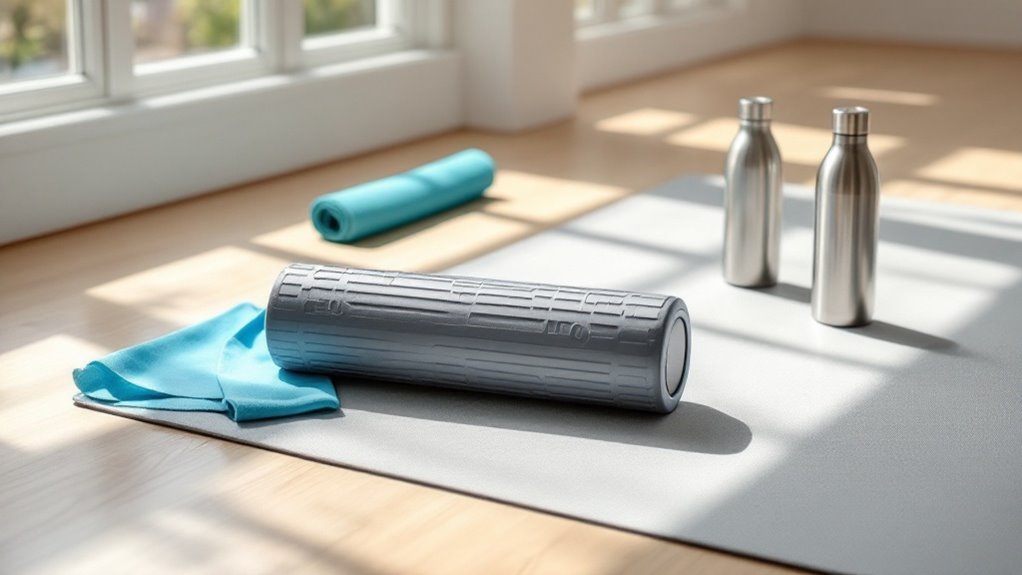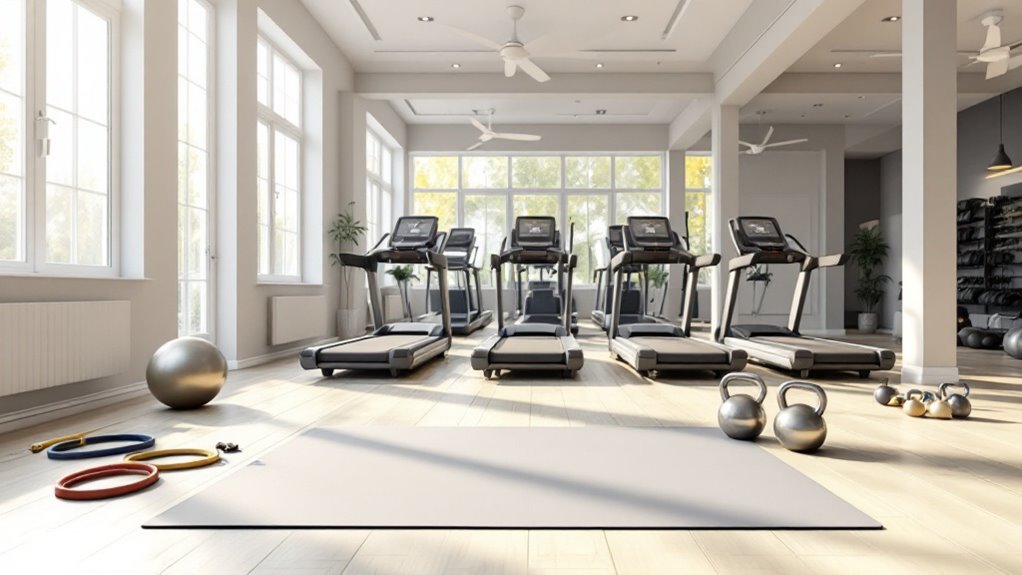7 Day Gym Program

This thorough 7-day gym program balances strength training, cardio, and recovery to enhance fitness gains. Monday kicks off with full-body strength work, followed by high-intensity cardio on Tuesday. Wednesday targets upper body, while Thursday focuses on active recovery. Lower body power dominates Friday, with endurance and core work on Saturday. Sunday provides essential rest. This strategic rotation maximizes muscle growth, fat loss, and overall conditioning. The journey to peak performance awaits.
Key Takeaways
- Full-body strength training on Monday sets the foundation, focusing on compound movements like squats, deadlifts, and bench presses.
- High-intensity cardio sessions on Tuesday incorporate explosive movements with 30-45 second intervals and short rest periods.
- Wednesday targets upper body development through compound and isolation exercises, including bench press variations and arm supersets.
- Thursday offers active recovery with mobility work and light cardio, while Saturday combines endurance training with core-focused exercises.
- Sunday provides complete rest and rejuvenation through stretching, adequate sleep, and stress-reducing activities for optimal recovery.
Monday: Full Body Strength Training

Every successful fitness journey begins with a strong foundation, and Monday's full body strength training serves as the cornerstone of this extensive weekly program.
Success in fitness starts with foundational strength training, setting the tone for your entire workout week.
This session focuses on compound movements that involve multiple muscle groups simultaneously, maximizing workout efficiency and caloric burn.
Proper nutrition and recovery between training sessions is essential for optimal muscle growth and strength development.
The workout incorporates key exercises: squats, deadlifts, bench presses, and overhead presses. These movements build functional strength while establishing proper form and mind-muscle connection.
Three sets of 8-12 repetitions per exercise provide the ideal balance between strength development and muscle endurance.
Rest periods are kept to 60-90 seconds between sets, maintaining an enhanced heart rate throughout the session.
Tuesday: High-Intensity Cardio

Following a day of intensive strength work, Tuesday evolves into high-intensity cardio training to improve fat burning and cardiovascular endurance. The session typically begins with a 10-minute dynamic warm-up, followed by alternating rounds of high-intensity intervals.
The workout incorporates explosive movements like burpees, mountain climbers, and jump squats, paired with short rest periods. Each exercise is performed for 30-45 seconds at maximum effort, followed by 15-30 seconds of rest. The entire circuit is repeated 4-6 times.
This intense cardio session concludes with a 5-minute cooldown, maximizing the body's fat-burning potential while building mental toughness through challenging intervals. Even these brief 20-minute cardio sessions can significantly improve heart health and boost overall metabolism when done consistently.
Wednesday: Upper Body Focus

Midweek muscle-building shifts into high gear with Wednesday's extensive upper body training session.
The workout targets chest, shoulders, back, and arms through compound movements and isolation exercises, maximizing upper body development and strength gains.
Strategic blend of compound and isolation work hits every major upper muscle group for maximum strength and development potential.
The session begins with bench press variations, followed by military presses and bent-over rows.
Following a progressive training approach helps prevent fitness plateaus while maintaining steady strength improvements.
Supplementary exercises include dumbbell flyes, lateral raises, and face pulls to guarantee complete muscular development.
The workout concludes with bicep and tricep supersets.
Rest periods remain controlled at 60-90 seconds between sets, maintaining workout intensity while allowing adequate recovery.
This structured approach guarantees balanced upper body development and sustainable progress.
Thursday: Active Recovery and Mobility

After Wednesday's intense upper body session, the body requires strategic recovery to maintain momentum and prevent overtraining.
Thursday focuses on active recovery through mobility work, light cardio, and stretching exercises that promote blood flow and muscle repair.
The day's routine includes 20 minutes of low-intensity swimming or walking, followed by dynamic stretching sequences targeting major muscle groups.
Foam rolling sessions address any tight areas, while yoga-inspired movements improve flexibility and joint mobility.
This recovery day isn't about intensity but rather movement quality and restoration, preparing the body for Friday's upcoming training session while allowing proper adaptation from previous workouts.
Taking a break from heavy bench press variations allows your chest and supporting muscles to fully recover and rebuild stronger.
Friday: Lower Body Power

With renewed energy from Thursday's recovery session, Friday brings an explosive focus on lower body power development. This intense training day emphasizes explosive movements and strength-building exercises designed to improve athletic performance and muscle power generation.
- Primary power movements:
- Box jumps (4 sets of 5 reps)
- Jump squats (3 sets of 8 reps)
- Power cleans (5 sets of 3 reps)
The session concludes with supplementary exercises targeting stabilizer muscles and maintaining proper form.
Athletes should focus on explosive concentric movements while maintaining control during eccentric phases. Following a progressive overload approach helps ensure continuous improvement in power and strength. Proper warm-up and technique are essential for preventing injury and maximizing power output gains.
Saturday: Endurance and Core

Saturday's endurance and core training serves as the final building block in the weekly progression, combining sustained cardiovascular work with targeted midsection strengthening.
The session starts with 30-45 minutes of steady-state cardio, maintaining a heart rate between 120-140 BPM, followed by dynamic core circuits.
Core work includes planks, Russian twists, bicycle crunches, and hanging leg raises, performed in 3-4 supersets. Each movement is executed for 45 seconds with minimal rest between exercises.
This combination develops muscular endurance while enhancing the body's ability to stabilize during compound movements throughout the week.
Regular participation in these aerobic fitness workouts has been shown to significantly improve heart health and boost daily energy levels.
Sunday: Rest and Rejuvenation

Rest constitutes an essential component of any effective training program, making Sunday an important recovery day that allows the body to repair, rebuild, and strengthen itself.
Taking time to rest and recover is vital for reaching your fitness goals and maximizing the benefits of training.
This dedicated recovery period optimizes the previous week's training efforts while preparing for the upcoming week's challenges.
Key recovery activities include:
- Light stretching and mobility work to maintain flexibility and reduce muscle tension
- Adequate hydration and balanced nutrition to support muscle repair and glycogen replenishment
- Quality sleep (8-9 hours) combined with stress-reducing activities like meditation or gentle walking
Active recovery promotes better adaptation to training stress while preventing overtraining and reducing injury risk.
Mental rejuvenation is equally important as physical recovery.
Working with a personal trainer's expertise can help ensure your recovery techniques align properly with your individual fitness goals and current training intensity.
Frequently Asked Questions
What Should I Eat Before and After Each Workout Session?
Pre-workout nutrition should include complex carbs and moderate protein 2-3 hours before training – oatmeal with banana, whole grain toast with eggs, or yogurt with berries.
Post-workout, consume protein and fast-digesting carbs within 30 minutes – protein shake with fruit, grilled chicken with rice, or tuna sandwich.
Stay hydrated throughout, drinking water before, during, and after exercise.
How Long Should I Wait Between Sets During Strength Training Days?
Like a skilled conductor directing their orchestra, rest periods between strength training sets require precise timing.
The ideal rest interval ranges from 2-5 minutes for heavy compound lifts and 1-2 minutes for isolation exercises. Maximum strength gains demand longer breaks, while muscle endurance benefits from shorter intervals.
For beginners, tracking rest periods with a stopwatch guarantees consistent recovery and maintains workout intensity.
Can I Switch Around the Days to Fit My Personal Schedule?
Adjusting workout days to fit a personal schedule is perfectly acceptable as long as proper rest periods between muscle groups are maintained.
The key is ensuring at least 48 hours of recovery between training the same muscle groups. This flexibility helps maintain consistency while accommodating work, family, or other commitments.
Smart scheduling adaptations often lead to better program adherence and long-term success in fitness goals.
What's the Recommended Water Intake for This Seven-Day Training Program?
Proper hydration is essential for ideal training performance.
The recommended daily water intake during a seven-day training program is 0.5-1.0 ounces per pound of body weight.
Athletes should drink 16-20 ounces 2-3 hours before exercise, 8-10 ounces 15 minutes before, and 8-10 ounces every 15-20 minutes during training.
Post-workout, consume 16-24 ounces for every pound lost through sweat.
Should Beginners Start With Lighter Weights or Modified Versions of Exercises?
Better safe than sorry when starting a fitness journey.
Beginners should absolutely start with lighter weights and modified exercises to master proper form and build foundational strength. This approach reduces injury risk and guarantees sustainable progress.
As technique improves and confidence builds, weights can gradually increase.
Modified versions like wall pushups or assisted squats help develop correct movement patterns before advancing to standard exercises.
Final Thoughts
Like a masterfully conducted symphony, this seven-day program coordinates the body's transformation through strategic waves of intensity and rest. Each day builds upon the last, creating a powerful crescendo of strength, endurance, and renewal. From Monday's foundational strength to Sunday's essential restoration, this rhythm mirrors nature's own cycles. Through this balanced approach, fitness goals harmoniously correspond with the body's natural capabilities and limitations.


